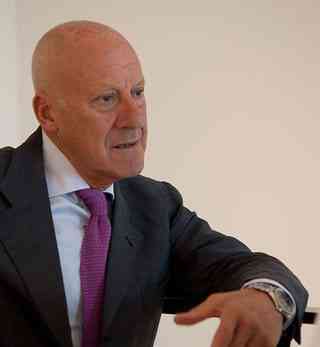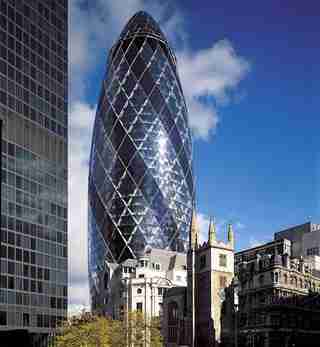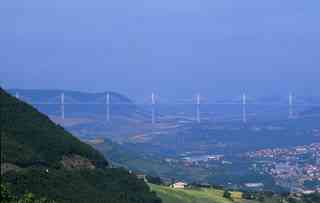November 13,2022
Norman Foster, Past and Present
by David Stewart

Norman Foster
Glass and steel combined into mesmerizing modernist silhouettes is British starchitect Norman Foster's stylistic hallmark, from London's Swiss Re Tower to New York City's Sperone Westwater gallery to the revamped Museum of Fine Arts, Boston —the latter two are featured in AD 's January 2011 issue. Our round-the-world slide show of Foster projects highlights some of the legendary architect's triumphs.

30 St. Mary Axe, 2004
Formally known as 30 St. Mary Axe, for its address, the tapering UK headquarters of the global reinsurer Swiss Re stands on the London skyline like a giant pickle—which explains why some wags have called the 41-story structure the Gherkin or the Crystal Phallus.

Millau Viaduct, 2004
Standing more than 1,100 feet above the Tarn River in southern France, the elegant four-lane Millau Viaduct is the tallest road bridge in the world. Foster and French engineer Michel Virlogeux designed its sail-like combination of cables and pylons to take up as little visual space as possible.
Modernist Villa, 2002
Capitalizing on stunning views of the Mediterranean, Foster created a seven-level villa in France with a 30-foot-tall glass façade that opens onto a terrace and white-sailcloth shades that keep high-noon sunlight at bay.
Hearst Tower, 2006
In a renovation of the headquarters of the Hearst Corporation in New York City, Foster set a 46-story shaft of glass atop the company's original six-story building, which had been created in the 1920s by Ziegfeld Follies set designer Joseph Urban. The result is a modernist reimagining of the office tower Urban had originally envisioned for the site.
McLaren Technology Centre, 2004
The headquarters of Formula One carmaker McLaren in Woking, England, features a sensational whiplash-curve façade. Appearance is not the only dazzling aspect of its design—the manmade lake abutting the structure is a major component of the complex's cooling system.
Great Court, British Museum, 2000
By covering the Great Court of the British Museum in London with a netlike glass canopy, Foster not only gave the sprawling complex a central meeting place, he also created the largest enclosed public space in Europe.
Renault Distribution Centre, 1983
For the French carmaker's warehouse, showroom, and training facility in Swindon, England, Foster encased the glass building in a spidery yellow skeleton of tie rods and tendons. Now known as the Spectrum Building, it appeared as the villain Max Zorin's lair in the 1985 James Bond movie A View to a Kill.
Reichstag, 1999
Foster's four-year restoration of Berlin's majestic 1894 Reichstag—home to Germany's parliament—included the construction of a glass dome to symbolize government transparency. It offers visitors a 360-degree view of the capital city.
Asprey, 2003
Another design master, British interior decorator David Mlinaric, joined Norman Foster in the creation of the Asprey flagship in New York City, at the base of Trump Tower. The gloss-black framework surrounds huge sheets of glass that render the luxury goods store entirely transparent; at night, it resembles a glowing lantern.
Chesa Futura, 2004
Though the exterior of this apartment building in St. Moritz, Switzerland, resembles a giant lima bean—reflecting Foster's rounded geometries—its larch-shingle cladding references traditional Swiss architecture. Its name means "house of the future" in the local dialect, Romansh.
Great Glass House, 2000
In yet another "biggest" feat, Foster designed the world's largest single-span greenhouse as the centerpiece of the National Botanic Garden of Wales in Llanarthne, Carmarthenshire. The structure's hill-like profile artfully nestles into the rolling landscape of the 568-acre park.
Wembley Stadium, 2007
Able to host 90,000 visitors at a time, Wembley Stadium in London is the largest covered venue for soccer in the world. The towering illuminated arch is part of the support of the stadium's retractable roof.






